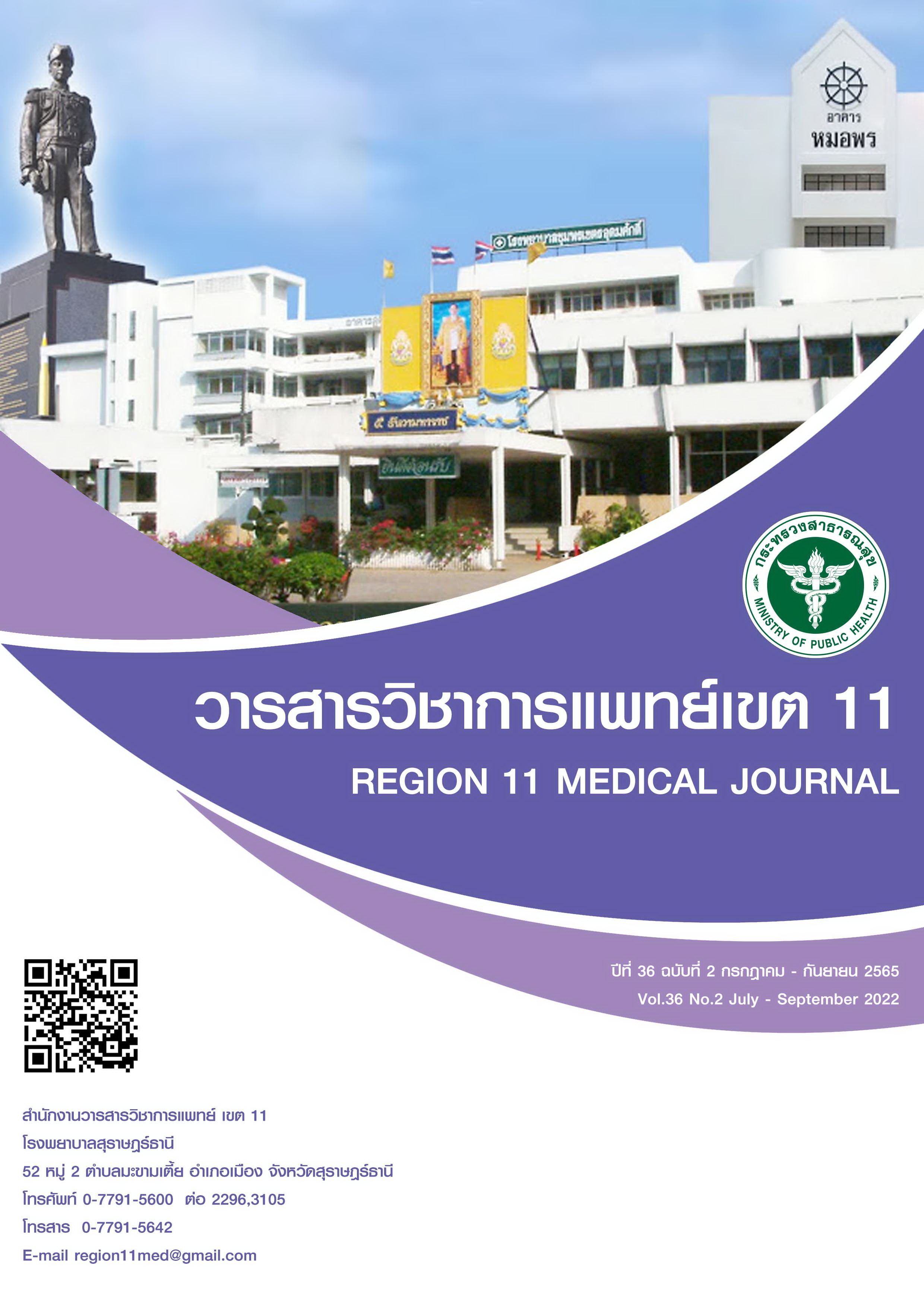A comparative study of tourniquet inflation pressure settings based on traditional tourniquet pressure versus limb occlusion pressure on pain score, blood loss in minor hand and wrist surgery, Inburi hospital, Singburi province
DOI:
https://doi.org/10.14456/reg11med.2022.12Keywords:
Blood loss, Limb occlusion pressure, Minor hand and wrist surgery, Pain score, Traditional tourniquet pressureAbstract
Background: The occlusion pressure technique in upper extremity orthopeadic surgery is generally set at 250 mmHg using traditional tourniquet pressure technique. Compared to this, the pressure adjusted based on limb occlusion pressure (LOP) method is lower and was reported to generate less pain at tourniquet site and still reduce amount of blood losses without compromising the visualization of surgical field.
Objective: To compare the differences on tourniquet site pain and intraoperative blood losses between traditional tourniquet pressure and LOP-based methods in minor hand and wrist surgery.
Method: This is a retrospective study using clinical records of 29 patients who underwent minor hand and wrist surgery in Inburi hospital from September 2019 to October 2021 focusing on their pain scores in the upper arm and the volume of intraoperative blood losses regarding the two different manouvers.
Results: The tourniquet inflation pressure settings based on limb occlusion pressure method resulted in a significantly lower mean pain score compared to the traditional method with mean pain scores of 2.9 ± 0.8 versus 3.9 ±0.7, respectively (p =0.001). However, there was no significant difference in volume of intraoperative blood losses between the two techniques.
Conclusion: The tourniquet inflation pressure settings based on limb occlusion pressurecaused less tourniquet site pain compared to the traditional tourniquet pressure setting in minor hand and wrist surgery without a difference in intraoperative blood losses.
References
Wolfe SW. Tendinopathy. In: Wolfe SW., Hotchikiss RN , Pederson WC., Kozin SH., Cohen MS. Green’s operative hand surgery. 7th ed. Philadelphia : Elsevier : 2017.p.1904-25.
Rettig AC. Wrist and hand overuse syndromes. Clinics in sports medicine 2001;20(3):591-611.
Stahl S, Kanter Y, Karnielli E. Outcome of trigger finger treatment in diabetes. J Diabetes Complications 1997;11(5):287–90.
Green DP. General Principles. In: Green DP., Wolfe SW., Hotchikiss RN , Pederson WC., Kozin SH. Green’s operative hand surgery. 6th ed. Philadelphia : Elsevier : 2010.p.3-24
David M, Rangaraju M, Raine A. Acquired triggering of the fingers and thumb in adults. BMJ 2017;359:j5285.
Ogufere WE, Giddins GE, Thom JS: Upper arm tourniquet pain in local anaesthetic surgery. J Hand Surg [Br] 1995;20:413-14.
Estebe JP., Naoures AL., Chemaly L., Ecoffey C. Tourniquet pain in a volunteer study : effect of changes in cuff width and pressure. Anaesthesia 2000;55:21-6.
Recommended practices for care of patients undergoing pneumatic tourniquet-assisted procedures. In: Perioperative Standards and Recommended Practices. AORN, Inc.; 2015.
McEwen AJ., Inkpen K., Younger A. Thigh tourniquet safety. The Surgical Technologist 2002;34:9-18.
Morehouse H., Haley G., Bradley L., Jaclyn J., Todd S., Patrick M., et al. Limb occlusion pressure versus standard pneumatic tourniquet pressure in open carpal tunnel surgery – A Randomized Trial. Orthopedic Research Society, Annual Meeting 2020; 2020 Feb 8-11; Phoenix Convention Center, Phoenix, Arizona; 2020.
Kalla TP, Younger A, McEwen JA, Inkpen K: Survey of tourniquet use in podiatric surgery. J Foot Ankle Surg 2003;42:68–76.
Younger A., McEwen JA., Inkpen K. Wide contoured thigh cuffs and automated limb occlusion measurement allow lower tourniquet pressures. Clinical Orthopaedics and Related Research 2004;28:286-93.
Noordin S., McEwen JA., Kragh JF., Eisen A., Masri BA. Surgical tourniquets in orthopedics. The Journal of Bone and Joint Surgery 2009;91:2958-67.
Oragui E., Parsons A., White T., Longo GU., Khan WS. Tourniquet use in upper limb surgery. HAND 2011;6:165-73.
Lee OS., Lee MC., Han HS. Efficacy and safety of a new elastic tourniquet cuff in total knee arthroplasty: a prospective randomized controlled study. BioMed Eng OnLine 2017;16:102.
Saleh E., Saleh J., Govshievich A., Caron GF., Lin JC., Tremblay DM. Comparing Minor Hand Procedures Performed with or without the Use of a Tourniquet: A Randomized Controlled Trial, Plastic and Reconstructive Surgery. Global Open 2021; 9:3513.
Sharma JP, Salhotra R. Tourniquets in orthopedic surgery. Indian J Orthop. 2012;46(4):377-83.
Olivecrona C, Ponzer S, Hamberg P, Blomfeldt R. Lower tourniquet cuff pressure reduces postoperative wound complications after total knee arthroplasty. J Bone Joint Surg Am. 2012;94(24):2216-21.
WHO Guidelines for the Pharmacological and Radiotherapeutic Management of Cancer Pain in Adults and Adolescents. Geneva: World Health Organization; 2018.
Kang H. Sample size determination and power analysis using the G*Power software. J Educ Eval Health Prof. 2021;18:17.
Downloads
Published
How to Cite
Issue
Section
License
Copyright (c) 2022 Region11Medical Journal

This work is licensed under a Creative Commons Attribution-NonCommercial-NoDerivatives 4.0 International License.






